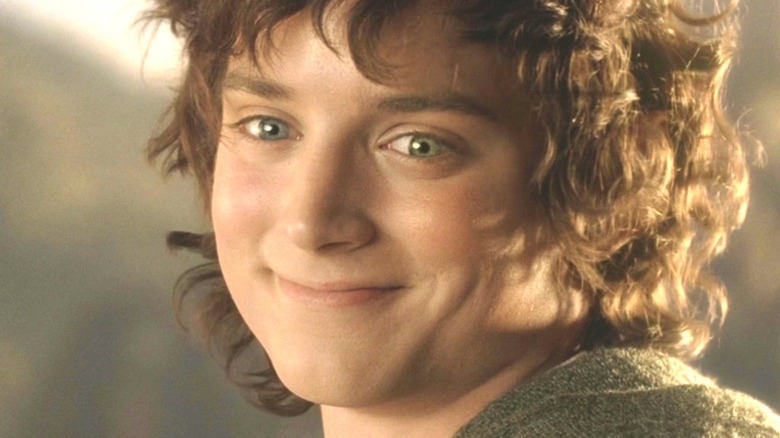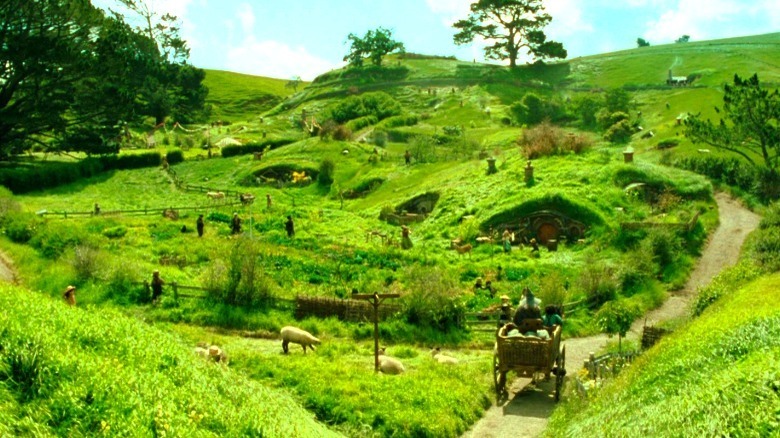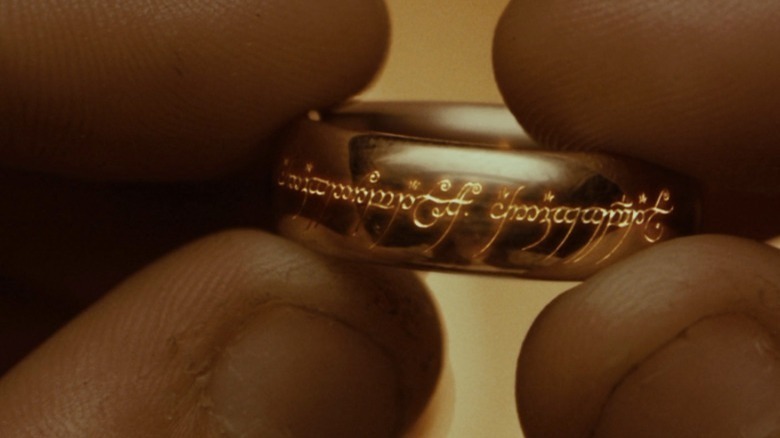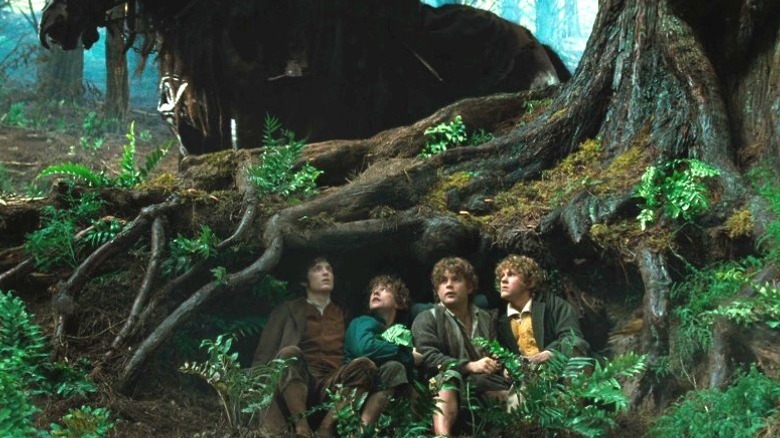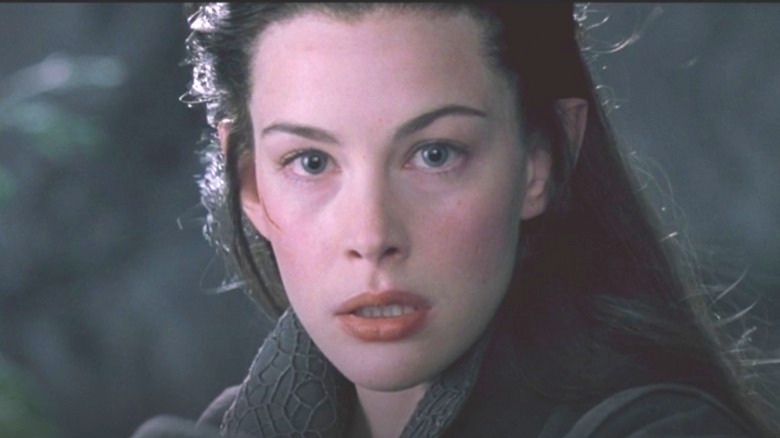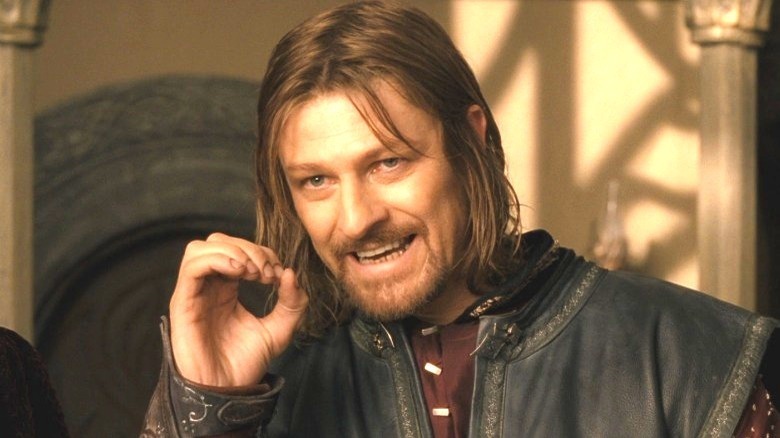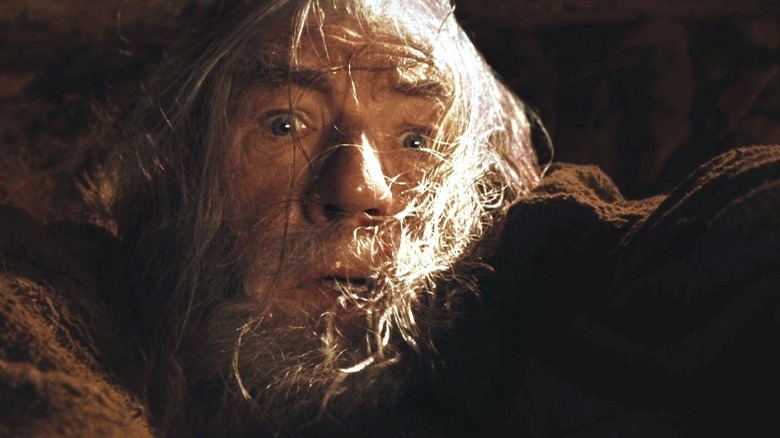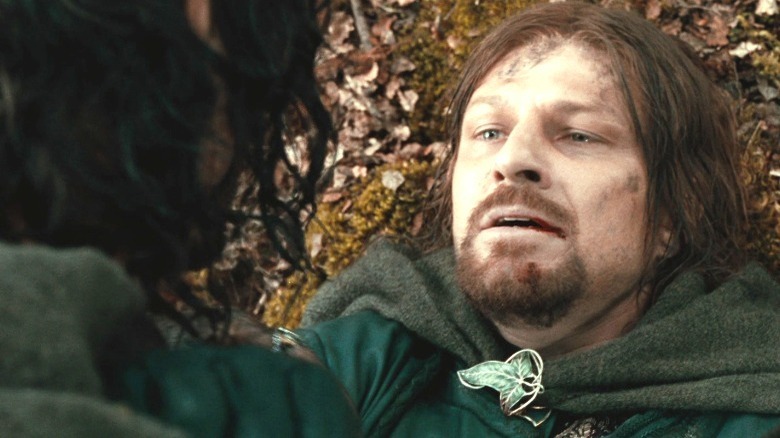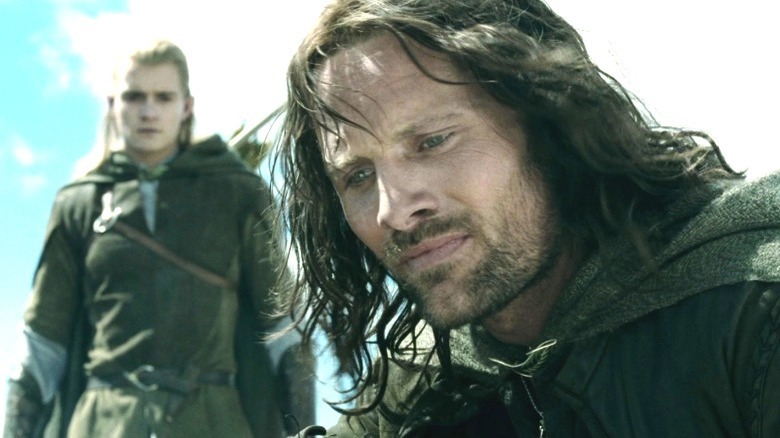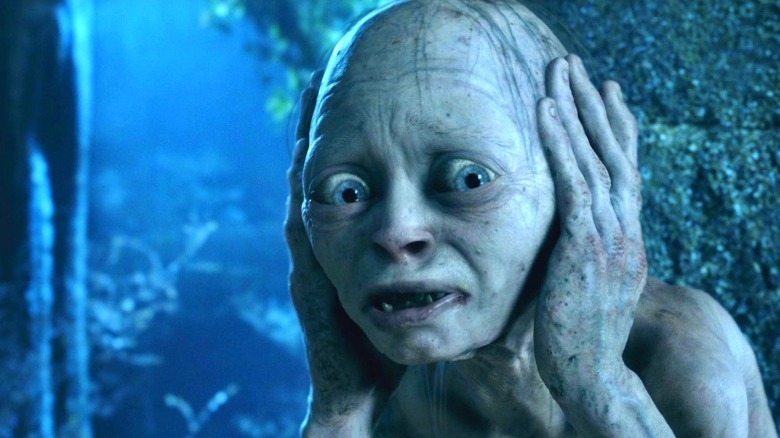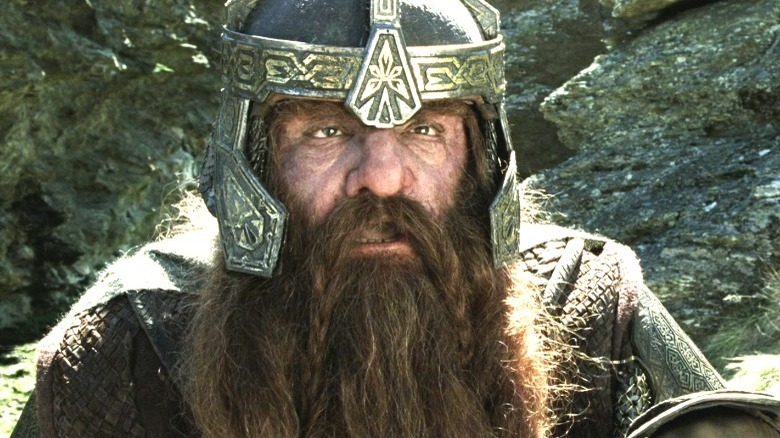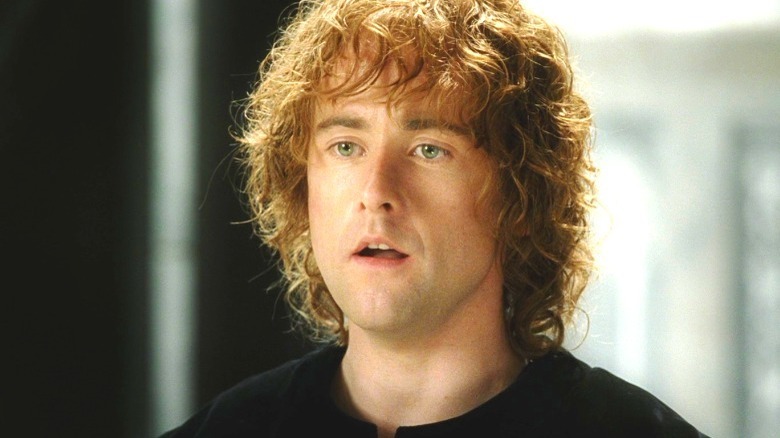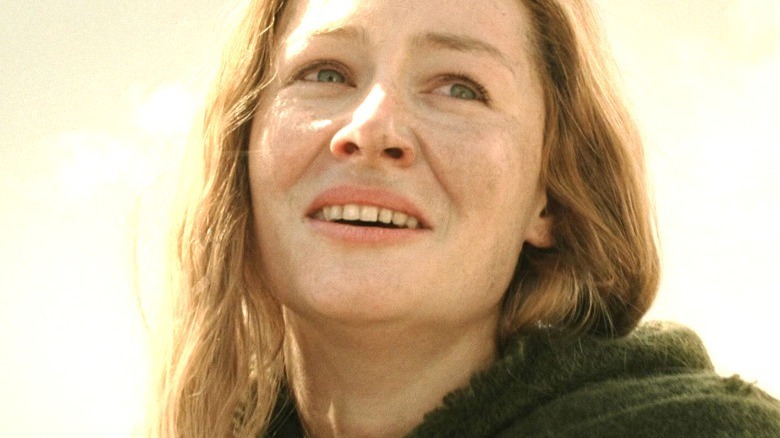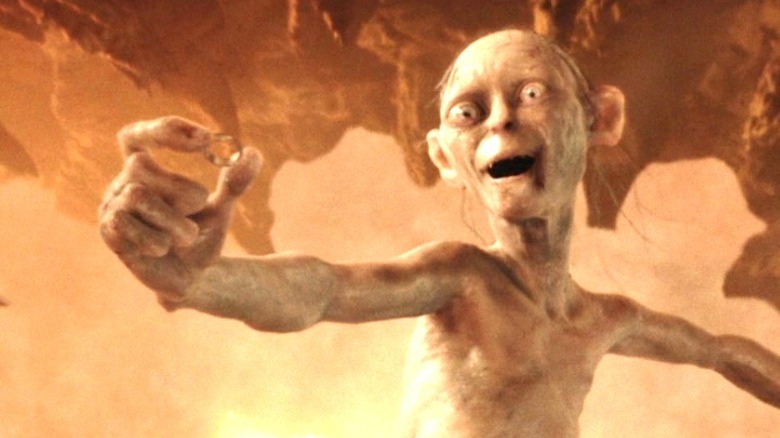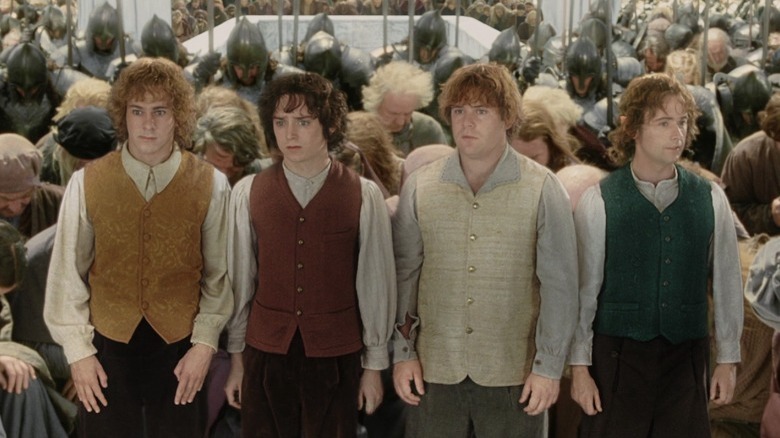The Most Pause-Worthy Moments In The Lord Of The Rings Trilogy
2021 marked the 20th anniversary of Peter Jackson's epic adaptation of J.R.R. Tolkien's fantasy masterpiece, "The Lord of the Rings." The project was a labor of love for Jackson, who directed the films as well as co-wrote them alongside Philippa Boyens and Fran Walsh. In December of 2001, fans flooded into theaters to see the first movie of the trilogy, "The Fellowship of the Ring." The second and third installments followed in 2002 and 2003, as the fan base gained rolling momentum with each film's release.
"The Lord of the Rings" is the saga of Frodo Baggins (Elijah Wood), a hobbit who leaves his peaceful life in the Shire to take on the daunting quest to destroy the One Ring of Power. He is soon joined on his journey by many of Middle-earth's greatest heroes who aid him along the way, including the wizard Gandalf (Ian McKellen), the lost king of Gondor, Aragorn (Viggo Mortensen), the elf prince Legolas (Orlando Bloom), and the loyal dwarf, Gimli (John Rhys-Davies).
It's not easy to describe the impact that "The Lord of the Rings" trilogy has had over the last two decades and counting — not only on its loyal fans, but on the art of filmmaking as well. The time and energy that the director, cast, and crew put into the making of these films proved to be worth the seven years of production, and there are so many incredible sequences that left audiences in awe. While it's tough to narrow down the most impressive moments of the trilogy, here are some of the scenes from Peter Jackson's "Lord of the Rings" trilogy that made us press pause on our remotes.
Seeing Hobbiton on the big screen
As the town that serves as home to Frodo and Bilbo Baggins (Ian Holm), Hobbiton is the quintessential ideal of a quiet and idyllic locale where any hobbit would love to live. Tolkien based the fictional village on the beauty and tranquility of the English countryside, and it's where the tale truly begins. The description of Hobbiton in the novels not only gives readers a sense of what life is like for a hobbit, but has made generations of fans yearn for their own cozy little hobbit hole.
Peter Jackson — a superfan of the novels — and the rest of "The Lord of the Rings" crew knew they had to find the perfect location to film the Hobbiton scenes, and they found what they were looking for in Waikato, New Zealand. According to the Hobbiton Tours website, a 1,250-acre farm would eventually become the Shire. The website also states that it took over nine months of construction to build the hobbit village, with the film crew actually receiving help from the New Zealand Army.
The result of the filmmakers' hard work paid off in the final cut of the film. At the beginning of "The Fellowship of the Ring," we see Frodo and Gandalf riding in a carriage down the pastoral streets of Hobbiton, and for those who've read the books, it feels like the pages of the novels come to life. In 2002, guided tours were made available for anyone to come and visit the set, and Jackson returned to rebuild the location once again with the filming of "The Hobbit" trilogy in 2009.
The reveal of the One Ring
After his unforgettable 111th birthday celebration, Bilbo makes preparations to leave Hobbiton for good. Although it proves to be an immense struggle for him, Bilbo manages to leave the One Ring behind with Frodo, along with most of his belongings and the deed to his home, Bag End. At Gandalf's direction, Frodo keeps the ring "secret" and "safe," even though he has no idea of the true power it holds.
Gandalf, having his suspicions, leaves the Shire to find out what he can about Bilbo's mysterious ring. When he returns, he is haggard and disturbed, not the calm and collected wizard he once was. Frodo hands over the ring, only to be surprised by Gandalf throwing it into the fireplace.
What follows is, perhaps, one of the most recognizable shots in the trilogy. Gandalf takes the ring out of the fire and places it in Frodo's hand, assuring the hobbit that it is "quite cool." Moments later, writing appears across the band, which Gandalf ominously translates for Frodo and the audience: "One ring to rule them all, one ring to find them, one ring to bring them all and in the darkness bind them."
Not only is this phrase insanely quotable, but it establishes what will become the central plot of the series. The One Ring of Power is an evil artifact that must be destroyed at all costs, and poor Frodo is the one to do it. Although Gandalf hates sending his hobbit friend on such a dangerous errand, he hopes that Frodo's bravery and loyalty will get the job done.
The hobbits hiding from the Black Rider
As Frodo begins his journey out of the Shire, he is joined by his loyal friend, Samwise Gamgee (Sean Astin), and later by the mischievous duo Pippin Took (Billy Boyd) and Merry Brandybuck (Dominic Monaghan). Merry and Pippin literally bump into Sam and Frodo while on the run from the crotchety Farmer Maggot, after stealing some of his prized vegetables.
After the four hobbits tumble down a hill, they gather themselves to their feet just as Frodo senses a dangerous presence coming down the road. Frodo frantically commands the others to hide, and they find the perfect spot under the roots of a large tree.
The scene is one of the most suspenseful moments in the movie, with the four hobbits huddled together in a dank hole teeming with creepy-crawlies, as the terrifying figure of the hooded dark rider — one of the dreaded Ringwraiths — approaches. As the Ringwraith sniffs out his unseen prey, Frodo almost gives into temptation and nearly puts on the One Ring. Luckily for our heroes, the rider is distracted and passes without discovering their hiding place. It's a wake-up call for the hobbits that they aren't in Hobbiton anymore.
Arwen facing off against the Ringwraiths
Although Tolkein's work is held in high esteem, the unfortunate truth is that there is a sad lack of a female presence in his novels. To make up for this, the writers of "The Lord of the Rings" film trilogy expanded the role of an underutilized character from the novels: Arwen Evenstar (Liv Tyler). The writers gave Arwen a much larger part in the films, sometimes adding her into scenes from which she was absent in the books.
In "The Fellowship of the Ring," the hobbits' harrowing ordeal on Weathertop results in Frodo being stabbed by a Morgul blade — which, if left untreated, will turn Frodo into a shadow of himself, not unlike the Ringwraiths. Luckily, Arwen comes upon the group and insists on taking Frodo to her father, Elrond (Hugo Weaving), to get healed before it's too late. What follows is a tension-fueled chase scene, with Arwen riding as fast as she can with Frodo in tow, and the Nazgul hot on their heels.
The chase comes to a climax when Arwen and Frodo cross the Ford of Bruinen. In a show of great courage, Arwen challenges the riders: "If you want him, come and claim him." It's tough not to be impressed by Arwen's heroism in that moment, especially for a character who was essentially wasted in the original novels. She then conjures up a great wave to wash away the enemies. This scene is truly memorable — not only for the impressive special effects, but also for the way it establishes Arwen's character in the films.
The meme heard 'round Middle-earth
One does not simply rewatch the "council of Elrond" scene in "The Fellowship of the Ring" without pausing at the exact moment that Boromir makes his iconic pose. You know the one — he's looking very serious and holding up his hand with his fingers forming a circle, indicating the Eye of Sauron. Meanwhile, the audience is picturing their own fill-in-the-blank text superimposed over the image.
In the very slim chance that you are in the dark on this one, the "One Does Not Simply" meme was a popular fad that spammed the internet for several years, in which someone would start a phrase with "One does not simply," and then finish the thought accordingly. As stated by Knowyourmeme.com, this viral trend first cropped up in 2004, when it was used on the community humor website, YTMND ("You're the man now, dog!"). Since then, millions of varieties of the meme have been generated by users online, with some hilariously clever renditions.
It's also refreshing to note that the actor himself, Sean Bean, is very aware of the meme and finds it quite amusing. In fact, he once told Radio Times magazine that he thinks the memes featuring his face will be his "unintended legacy" (via Independent), and he seems to be totally on board with it. In a video interview with Metro US in 2015, Bean even deigned to read a few of the most popular memes for viewers. What a guy!
Gandalf vs. the Balrog
As the wizard to end all wizards, Gandalf the Grey is the epitome of wisdom, power, and kindness. He acts as a guide and mentor to those who follow him, yet he is also a loyal friend, and a voracious fighter that any good guy is lucky to have on their side.
Perhaps the most spectacular scene in "The Fellowship of the Ring" is Gandalf's face-off against the Balrog in the Mines of Moria. Not only are the special effects for the creature itself awe-inspiring, but we get to see Gandalf looking like an incredible badass. The number of times the line "You shall not pass!" has been quoted and parodied over the last 20 years is incalculable, and it has prevailed in the minds of "The Lord of the Rings" fans for good reason.
Just as we cheer for Gandalf while he holds back the monstrous foe, so we weep for him when he falls into the abysmal depths below. No one can forget the image of Gandalf clinging to the edge of the rock before his final counsel for the fellowship: "Fly, you fools!" Even those who knew Gandalf would return in the second film couldn't help but feel something akin to grief at his loss. For the ones for whom Gandalf's fall came as a complete surprise, you probably had to press pause on your remote to ask yourself what the heck just happened.
Boromir's heroic death
Though he only plays a direct role in the action during the first film of "The Lord of the Rings" trilogy (and only in the second half), the character of Boromir has a surprising impact on the series as a whole. Part of that is likely due to the superb performance of actor Sean Bean, yet it can also be attributed to the writing team's careful consideration of the character's development.
It could easily be misconstrued that Boromir is an antagonist, when in fact he is much more complex than that. In truth, he is a man desperate to save his people, and that desperation is a weakness that the One Ring seeks to exploit. When Boromir tries to take the ring from Frodo by force in the third act of "The Fellowship of the Ring," he immediately recognizes his error and attempts to compensate by doing what he was meant to do: protect the innocent.
Sadly, Boromir finds death in a hail of Uruk-hai arrows while defending Merry and Pippin during an attack. With his dying words, he confesses his faults to Aragorn, while pledging his final allegiance to the true king of Gondor. The heartbreaking scene is enough to bring a tear to anyone's eye, and might have you reaching for the pause button so you can compose yourself.
Aragorn kicks the orc helmet (aka the behind-the-scenes fact every fan knows)
Almost every "The Lord of the Rings" superfan will immediately know what the title of this slide refers to, but for those who are scratching their heads in confusion, here's the skinny. In "The Two Towers," Aragorn, Legolas, and Gimli are tracking a pack of orcs who have kidnapped their friends, Merry and Pippin. During their search, they come upon a group of Rohirrim soldiers led by Eomer (Karl Urban). Eomer inform the trio that he and his soldiers recently ambushed a group of orcs, but left no survivors.
When Aragorn and the others find the remains of the orc horde, they find no trace of their hobbit companions. Believing the halflings may be dead, Aragorn lashes out by kicking a nearby orc helmet and screaming as he falls to his knees. While the kick was in the script, the scream was not, and that's because actor Viggo Mortensen broke his toe in that take. Yet instead of asking for the director to cut, Mortensen used his physical pain to express the torment his character was feeling in the moment. Talk about method acting! Once "LOTR" fans find out about this behind-the-scenes tidbit, it's impossible not to pause at that moment in the film — even just to show off their knowledge to whoever else might be in the room.
The conversation between Gollum and Smeagol
One of the most beloved characters in the trilogy, Gollum is a creature somehow both detestable and highly sympathetic. After being in possession of the One Ring for many years, the hobbit-like being once known as Smeagol has become an emaciated husk who lives only to hold his "precious" once more.
During "The Two Towers," Frodo and Sam encounter Gollum in the wilderness. In spite of Sam's suspicions, Frodo chooses to trust the pitiful soul and allow him to be their guide. This is perhaps the only act of kindness anyone has shown Gollum in all of his miserable existence, and the more Frodo demonstrates his sympathy for Gollum, the more he is wont to reveal his more vulnerable side.
Under layers of hatred and greed, there is still the person who was once Smeagol, and Frodo's compassion allows Smeagol to appear through the cracks. Where Gollum is suspicious and filled with rancor, Smeagol is trusting and eager to please. In one of the most memorable Gollum scenes, we see the two sides of the character arguing with one another as if they were two separate personalities — and indeed, in many ways, they are.
The scene was shot brilliantly by director Jackson in a two-camera setup, with motion capture performer Andy Serkis giving a magnificent depiction of the dual nature of the character. The audience really feels as if they are seeing a conversation between two people, and it's a scene worth pausing to take in the sheer genius of it all.
Aragorn tossing Gimli at Helm's Deep
The monumental Battle of Helm's Deep is inarguably the highlight of "The Two Towers." Taking up 39 minutes of the movie's total three-hour runtime, there are plenty of moments in the action-packed sequence for audiences to focus on. However, there is one bit in particular that not only adds to the excitement, but gets a big laugh from viewers.
You may remember the escape in "The Fellowship of the Ring," in which our heroes run for their lives in the ruins of Moria. At one point, Aragorn helps Sam get across a crumbling staircase by throwing him through the air to be caught by Boromir on the other side. However, Gimli proudly refuses the ranger's help, firmly stating: "Nobody tosses a dwarf!"
During the peak of the Helm's Deep battle, Gimli and Aragorn make their way to a bridge overflowing with Uruk-hai soldiers trying to break into the fortress. To get across the gap between the bridge and the stairs at the outer wall, Gimli reluctantly offers the only solution. Under his breath, he tells Aragorn that the ranger will have to toss him across the gap to get to the bridge. Aragorn agrees, although the dwarf first makes him promise not to tell Legolas. He does have his pride, after all.
Gimli's stocky figure being thrown through the air, landing triumphantly and hacking away at the Uruk-hai is not only an awesome sight to see, but a hilarious callback to the first film's joke that's definitely worth watching again.
Pippin sings for Denethor
Throughout the first two "Lord of the Rings" films, the hobbits Merry Brandybuck (Monaghan) and Pippin Took (Boyd) are rarely seen apart — which made it all the more shocking when the two were separated in the third entry, "The Return of the King."
After Pippin makes the mistake of revealing himself to Sauron through the mystical Palantir, Gandalf takes him to Minas Tirith, the capital city of Gondor. There, Pippin swears himself into the service of the city's steward, Denethor (John Noble). Though his hope is that he might make up for his grave mistake by doing something noble, Pippin finds that Denethor is not the ideal mentor. A man filled with bitterness over the loss of his son Boromir, Denethor would rather give into despair than fight for the hope of mankind.
As the soldiers of Gondor go off to battle, Denethor skulks in his grand hall with Pippin at his side. The steward requests that Pippin sing a song for him, and though the hobbit is clearly not in the mood for a lively tune, he obliges. As Pippin's voice echoes through the halls of Ecthelion, we see the men of Gondor ride into a hopeless battle that will seal their doom. It's a truly haunting moment, and Boyd's beautiful vocals are the perfect addition to the scene. The song he sings is one of sorrow and grief, and it will never leave your head (sadly, neither will the disturbing image of Denethor biting into a cherry tomato).
Eowyn kills the Witch King
Though Helm's Deep is one of the most memorable battle sequences in "The Lord of the Rings" trilogy, the Battle of Pelennor Fields from "The Return of the King" perhaps holds the most significance. It turns the tide of the War of the Ring, and gives the good people of Middle-earth the upper hand against Sauron's forces. While there are plenty of triumphant moments during this epic battle, there is one that stands out above the rest.
Eowyn (Miranda Otto), the shield-maiden of Rohan, has dealt with misogyny all of her life. While she is expected to be happy in her gilded cage at Theoden's court, all she ever wanted was to fight for the people she loves. She finally gets her chance when she disguises herself in armor and rides with the Rohirrim, along with her new hobbit friend, Merry.
Eowyn's time to shine comes when she faces off against the dreaded Witch King on the battlefield. As the leader of the Nazgul taunts that he cannot be killed by any man, Eowyn removes her helmet, declaring: "I am no man." She then offers the killing blow that destroys the Witch King once and for all, and gave fans one of the most victorious moments in the trilogy.
Gollum destroys the One Ring
"The Return of the King" features a dramatic climax that culminates within the perilous realm of Mordor. After traversing the treacherous plains, escaping the clutches of orcs, and ascending the volcanic Mount Doom, Frodo and Sam find the completion of their quest close at hand. All of their struggles and suffering will soon come to a conclusion — one way or the other.
As they enter into the heart of Mount Doom, Frodo hesitates at the edge of the fiery abyss. Much to the horror of his loyal companion — and the audience — Frodo has a sudden change of heart. Instead of destroying the ring, he decides to claim it as his own, placing it on his finger and making himself invisible. All seems lost, until the vengeful creature known as Gollum interferes. Determined to get to the One Ring, Gollum attacks the invisible Frodo and bites off the finger wearing the ring.
As any "Lord of the Rings" fan will tell you, Gollum inadvertently becomes the hero of the story at that moment. Back in "The Fellowship of the Ring," it was Gandalf himself that predicted Gollum would have a big part to play "for good or ill." Tragically, however, Gollum meets his demise when he plummets into the lava pit below, still clinging to his beloved treasure. The vision of Gollum sinking into the fiery liquid, followed by the One Ring, is one that will live forever in our minds.
Everyone kneels to the hobbits
After the One Ring is destroyed in "The Return of the King," the audience can finally breathe a collective sigh of relief. Sauron is defeated, the remaining fellowship has been reunited, and all is once again well in Middle-earth. Now it's time for Aragorn to finally take his place as the rightful King of Gondor.
The coronation scene is one of both celebration and solemnity. Everyone has gathered to see the crowning of Aragorn, their heroic leader and faithful friend. As the crowd of subjects bow and make way for their new king, Aragorn reaches the line of the four hobbits: Frodo, Sam, Pippin, and Merry. Yet when the halflings begin bowing to him, Aragorn protests, insisting that they "bow to no one." The new king then kneels before them and bows his head, and the massive crowd follows his example.
The sight of so many kneeling before the humble hobbits is enough to make anyone gasp in awe, as well as bring a tear to your eye. These four characters have come a very long way from their simple life in the Shire. Each of them has demonstrated his bravery and resilience in the face of impossible odds, and came out forever changed. This relevant moment reminds us of the most important theme of "The Lord of the Rings" trilogy: anyone — no matter their size or stature — is capable of doing great things.
